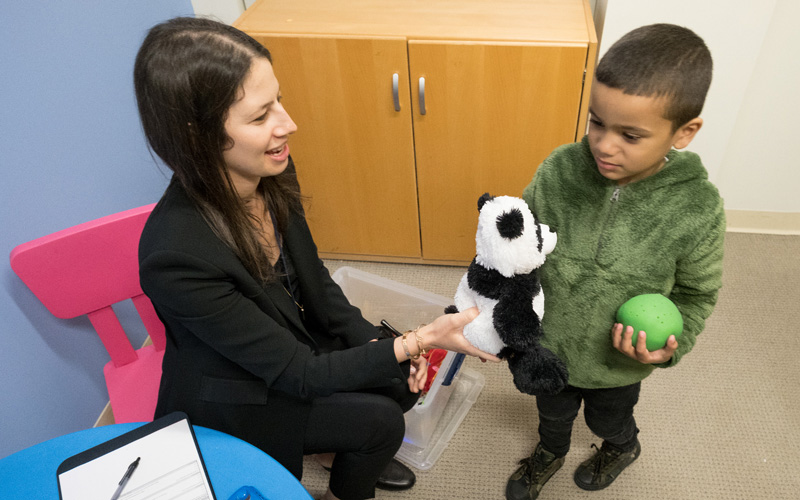In 2013, the fifth edition of the Diagnostic and Statistical Manual of Mental Disorders (DSM-5) included for the first time sensory reactivity within the diagnostic criteria for autism. The DSM-5 describes three categories of sensory differences:
- Sensory hyperreacitivty is an overresponsiveness to sensory stimuli that may take the form of individuals covering their ears in response to sounds, squinting or avoiding the sight of certain objects, resisting the feel of certain textures, or discomfort when touched by others.
- Sensory hyporeactivity is an underresponsiveness to sensory stimuli, which can result in significant safety concerns. For example, an individual who is hyporeactive may not respond to the sound of an alarm, the feel of pain or temperature, or the sight of a car passing by.
- Sensory seeking is an excessive interest in sensory stimuli. Individuals who are sensory seeking may repeatedly seek out the sight, feel, or sound of certain objects.
Each of these examples can affect daily living and quality of life. Research suggests up to 90 percent of individuals on the autism spectrum display sensory differences compared with people who do not have autism.

Paige Siper, PhD, Chief Psychologist of the Seaver Autism Center for Research and Treatment at the Icahn School of Medicine at Mount Sinai, meets with a patient.
A Sensory Assessment
If a child is displaying sensory hyperreactivities, hyporeactivities, or seeking behaviors that are affecting their daily functioning, a sensory assessment may be warranted. The goal of a sensory assessment is to identify personal sensory preferences. Everyone has sensory preferences, and by determining those preferences we can modify environments accordingly.
Over the past several years, teams at the Seaver Autism Center for Research and Treatment at the Icahn School of Medicine at Mount Sinai developed a novel sensory assessment called the Sensory Assessment for Neurodevelopmental Disorders (SAND). The SAND combines a semi-structured, clinician-administered observation and a corresponding caregiver interview. Clinicians observe, within an exam setting, how a child responds to stimuli that prompt sensory responses, and they also interview caregivers about their child’s daily experiences.
Following an assessment, parents will learn about their child’s unique sensory preferences and sensitivities, and then an individualized treatment plan can be developed and implemented. Adjustments in an individual’s sensory experiences can have a profound impact on adaptive behavior, social engagement, and learning.
Services at the Seaver Autism Center
The Seaver Autism Center is a multidisciplinary program with a large research focus ranging from natural history studies that track change over time to clinical trials that test new treatments. All individuals participating in research at the Center receive an autism-focused research evaluation. The Center also offers neuropsychological and psychoeducational evaluations, individual psychotherapy for those on the autism spectrum and their siblings, parent training, and medication management. The Seaver Autism Center has a large community outreach program that offers social skills groups and training for both families and professionals. The Center has a variety of collaborations with local cultural institutions in New York City such as the American Museum of Natural History and the Guggenheim Museum.
Over the past year, the Center has made it a priority to improve care and better support individuals on the autism spectrum’s sensory needs. Our teams developed Sensory Toolkits that are now available within Mount Sinai’s pediatric emergency departments and at specialist outpatient offices. We are starting to disseminate the toolkits to other practices within and outside of the Mount Sinai Health System with the goal of improving the patient experience. Each kit has several sensory tools, as well as an information sheet that explains the intended use of each tool to satisfy sensory needs and ultimately to make each person’s experience more comfortable. Families can take the kits home with them.
The Seaver Autism Center also developed a learning module to train physicians, clinicians, and staff members within different disciplines how to best support neurodiverse patients. They are actively collecting data on both of these initiatives to ensure these new programs are serving their intended purpose. Finally, our teams are surveying caregivers of children on the autism spectrum to determine which sensory interventions and supports have and have not worked for their child.
This article has been republished with permission from The Mount Sinai Health System. You may view the original article, published on April 8, 2022, at https://health.mountsinai.org/blog/what-are-sensory-processing-differences-and-how-do-they-relate-to-autism/.
Paige Siper, PhD, is a licensed clinical psychologist, Chief Psychologist of the Seaver Autism Center for Research and Treatment at the Icahn School of Medicine at Mount Sinai, and an Assistant Professor in the Department of Psychiatry. She has expertise in the diagnosis, neuropsychological assessment, and treatment of children and adults with a variety of neurodevelopmental disorders (NDDs). Dr. Siper’s research focuses on sensory processing and biomarker discovery using electrophysiological and behavioral approaches. Dr. Siper is the co-developer of the Sensory Assessment for Neurodevelopmental Disorders (SAND), which is the first clinician-administered observation and corresponding caregiver interview to quantify sensory reactivity symptoms specific to NDDs. In her role as Chief Psychologist, Dr. Siper oversees the psychological assessment process for a broad research portfolio ranging from natural history studies to clinical trials. Dr. Siper presents her work nationally and internationally and has appeared on CNN, Lifetime, CBS, and NBC.




